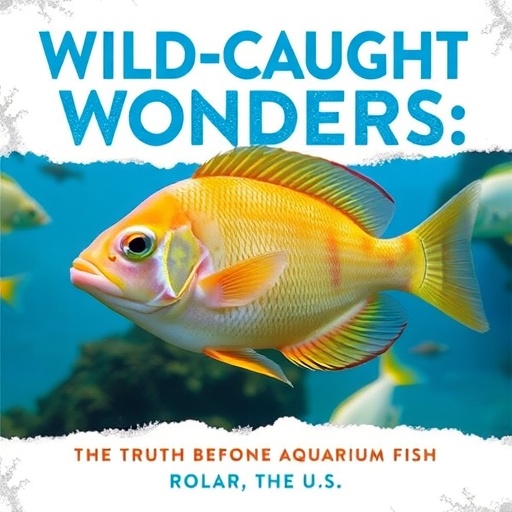A groundbreaking new study has unveiled alarming trends in the sourcing of marine aquarium fish sold through online retailers in the United States, exposing a staggering reliance on wild populations. Approximately 90 percent of these fish, spanning hundreds of species, originate directly from wild ecosystems primarily located in the western Pacific and Indian Ocean. This revelation carries profound implications for marine biodiversity, conservation strategies, and the sustainability of coral reef habitats, especially as the U.S. represents roughly two-thirds of the global aquarium fish import market.
This comprehensive analysis, spearheaded by Dr. Bing Lin, postdoctoral research associate at the University of Sydney’s Thriving Oceans Research Hub, dissects data culled from four major U.S.-based online aquarium retailers. The findings are unsettling: out of 734 fish species available for purchase, an overwhelming 655 species were exclusively wild-caught, in stark contrast to a mere 21 species bred solely through aquaculture methods. The research underscores the persistent dominance of wild capture in the ornamental fish trade despite technological advances in fish breeding.
Given the conservative framework employed in this study, the actual proportion of wild-caught fish is likely even higher. Dr. Lin’s methodological rigor aimed to provide a cautious baseline estimate, acknowledging inherent gaps in supply chain transparency and traceability. These findings highlight the significant opacity and unregulated nature of the supply chains feeding the booming online aquarium fish market, posing serious risks to marine conservation efforts globally.
Published today in the journal Conservation Biology, this study builds on Dr. Lin’s doctoral research conducted at Princeton University’s Center for Policy Research on Energy and the Environment. The paper meticulously maps species origins and sourcing practices, revealing that unmonitored extraction from coral reef ecosystems is jeopardizing both biodiversity and the delicate balance of reef communities. Such extraction pressures amplify the threat of overfishing and habitat degradation in ecologically sensitive regions.
One of the study’s critical revelations is the identification of 45 species under conservation concern within the aquarium trade, including 20 classified as threatened and an additional 25 experiencing population declines according to the International Union for Conservation of Nature (IUCN). Strikingly, 38 of these vulnerable species were sourced entirely from wild populations, underscoring the unsustainable pressures exerted by the ornamental fish market. This nexus between trade and conservation status raises urgent calls for improved regulatory frameworks.
Economic dimensions further complicate the dynamics. The analysis shows that aquarium fish cultivated through aquaculture are on average 28.1 percent cheaper than their wild-caught equivalents. This pricing disparity indicates that sustainable alternatives are not only feasible but may also provide a financially attractive option for both consumers and suppliers. However, entrenched consumer preferences, biological complexities in breeding certain species, and murky, unregulated supply chains perpetuate a predilection for wild-caught specimens.
Dr. Lin emphasizes the necessity for multi-pronged interventions, including investment in advanced aquaculture technologies, support for well-managed wild fisheries, credible eco-certification initiatives, and demand reduction for unsustainable wild captures. Enhanced traceability and regulatory oversight are paramount to ensuring that aquarium fish are harvested responsibly, enabling consumers to make more informed and ecologically sound purchasing decisions.
The study also sheds light on the socio-economic fabric underpinning the marine ornamental trade. Many commonly traded groups such as wrasses (Labridae), clownfish and damselfish (Pomacentridae), and gobies (Gobiidae) sustain the livelihoods of coastal communities in source countries, many situated in the biodiverse Indo-Pacific region. Any regulatory or market shifts must, therefore, balance environmental sustainability with the socioeconomic welfare of these populations.
Moreover, documented unsustainable fishing practices like cyanide fishing continue to plague the industry, exacerbating reef degradation. Nevertheless, the research points to successful examples of sustainable fisheries serving as blueprints for responsible marine aquarium trade, demonstrating that ecological preservation and economic viability can coexist through informed governance and community engagement.
While this investigation focuses primarily on the U.S. market, Dr. Lin cautions that similar challenges are evident in Australia, one of the world’s top twenty importers of live ornamental fish. The pervasive lack of transparency in the global aquarium trade supply chains creates significant hurdles in tracing fish origins and evaluating the ecological footprint of this burgeoning industry worldwide.
At its core, this study calls for heightened public awareness about the ecological ramifications of the marine aquarium trade. It advocates for consumers, policymakers, and industry stakeholders to collaboratively drive reforms that protect vulnerable reef species, promote sustainable practices, and support the coastal communities reliant on this trade for their economic livelihood. Balancing biodiversity conservation with human welfare remains the crux of a sustainable future for marine ornamentals.
In summary, the extensive reliance on wild-caught marine aquarium fish poses a critical threat to coral reef ecosystems and imperiled species, necessitating transformative changes in trade practices. By leveraging aquaculture innovations, regulatory enhancements, and consumer education, the ornamental fish sector can transition towards greater sustainability, securing both ecological integrity and economic resilience for generations to come.
Subject of Research: Animals
Article Title: Extent of threats to marine fish from the online aquarium trade in the United States
News Publication Date: 8-Oct-2025
Web References: Conservation Biology Journal
References: Lin, B. et al. “Extent of threats to marine fish from the online aquarium trade in the United States.” Conservation Biology, 2025. DOI: 10.1111/cobi.70155
Image Credits: Dr Bing Lin
Keywords: marine aquarium trade, wild-caught fish, aquaculture, coral reef conservation, biodiversity, sustainable fisheries, ornamental fish, marine ecosystems, trade transparency, IUCN threatened species




